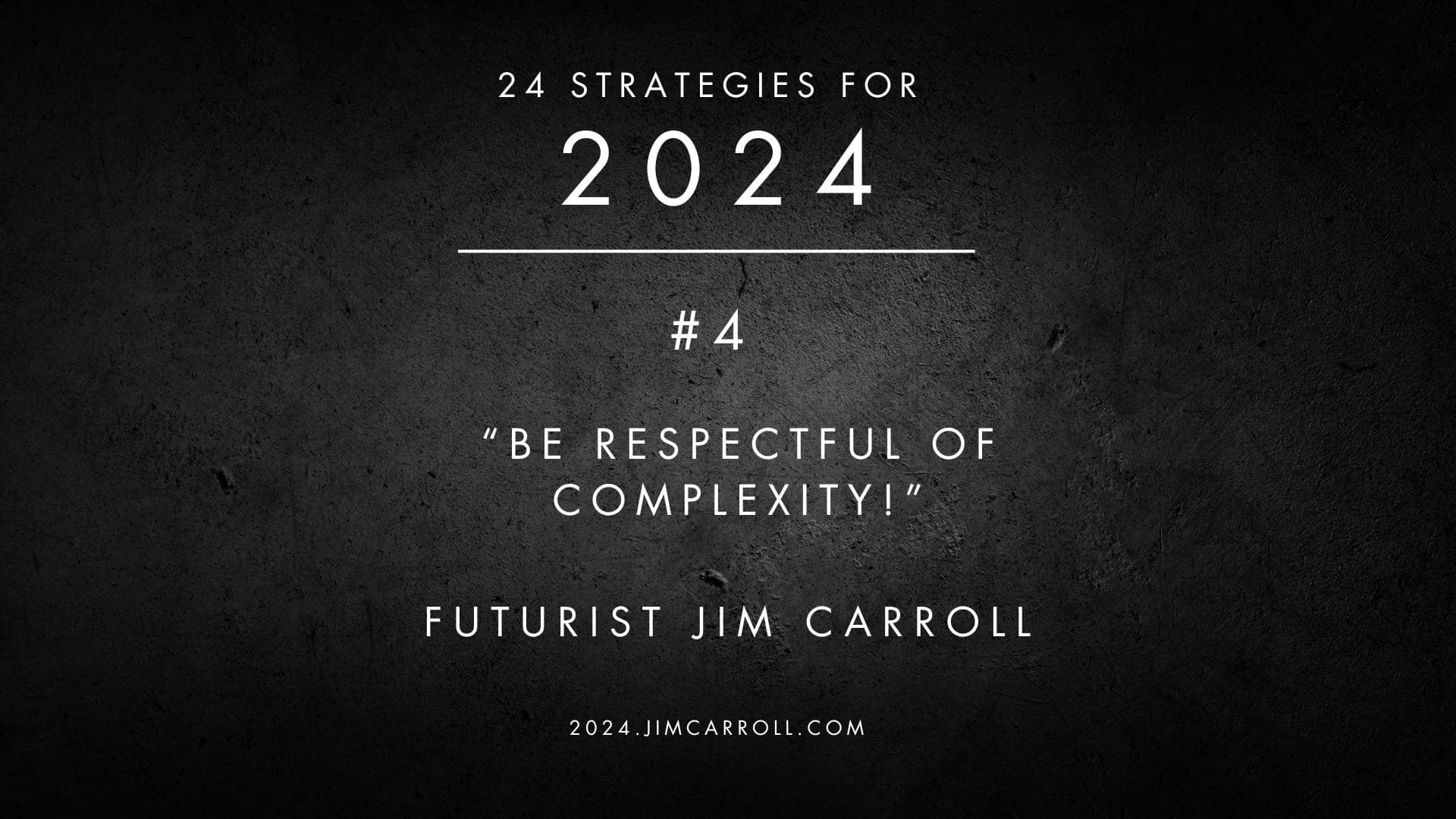Futurist Jim Carroll is running a series that began November 27, 2023, and will end on January 1, 2024 - '24 Strategies for 2024.' Rather than running a trend series for the upcoming year as he has previously, this series will examine a number of his personal beliefs on how to best align yourself with the future. There will be a post each weekday, excluding weekends and holidays, until the series runs its course. You will find it on his blog at
or on the website
The future isn't easy. In fact, it takes a lot of hard work.
Nowhere is that fact more relevant right now than with what is happening with AI. As the number of events I take on in the space and the number of inquiries I get for senior executive corporate events on the topic, it's pretty clear that for many, AI has become some sort of wonderful easy thing that you simply drop in - and magic happens.
And as most of us know, nothing could be further from the truth.
It's the latest shiny object in a long list of such objects.
Don't get me wrong - there is something wonderfully significant here that is going to have massive implications, both good and bad. And yet, I know three things are true. First, most people tend to overestimate the impact of any technology or trend in the short term but underestimate it in the long term. Second, AI is not 'one' thing - it's just a phrase that has been applied to a whole series of fast-evolving technologies, including large language models, machine learning, machine vision, and so much more, all of which are at different stages of maturity and sophistication. Third, while ChatGPT and other large-language-model systems are all the rage, they are but a small part of what is going on - the real magic is happening with robots and cobots and machine vision and machine intelligence and beyond.
That's why Strategy #4 in my series of 24 Strategies for 2024 is straightforward: appreciate complexity - with respect to AI and everything else.

I must admit that I was a little bit torn on the best way to position this strategy - for a time, for example, I was focused on the message to stop chasing simplicity by recognizing complexity.

Where are we today? It's early days yet. Earlier this week, I had a long conversation with one of the main authorities on AI at SAP, one of the largest enterprise software companies in the world. Essentially, SAP is behind much of the technology that powers a vast number of organizations - the stuff that helps them manage supply chains, inventory, manufacturing, financial and HR systems and so much more. Think of such systems as being the nervous system of today's modern corporation.
Here's what they told me, shared with permission.
Between Oct 1 and November 15, we collected data from about 430 companies on their AI journey, their AI interest, and the different “AI use cases” they were bringing to us. This was largely from CTO, CFO, and CIO audiences. See below a few facts.
- 21% brought us use cases that required generative AI, 44% required more traditional machine learning/predictive analysis type solutions, and nearly 1/3 of all requests could be solved without any AI at all!
- Only 3% (12) had a live use case of Generative AI that had resulted in a return on investment.
- Of those 12, 10 were using the exact same use case: Level 1 ticketing responses either for customer call centers or internal IT.
- 43% had officially funded GenerativeAI projects, while 96% were experimenting with genAI in some form.
- Of the CTO/CIO audience, only 16% are planning to build & train their own ML models or LLMs.
- the rest are looking to technology vendors like SAP, Salesforce, etc. to provide 'out of the box' pre-trained AI.
Let me parse this for you.
- first and foremost, AI is complex!
- second, fewer than one in five projects today involve technologies such as the type of thing you are working with such as ChatGPT; the majority involve predictive technologies which have already been available to us for quite some time
- third, the benefits of actually using things like ChatGPT, Bard, and Bing in a corporate form are pretty elusive so far
- fourth, most of those actual applications are simply to provide the ability for people to 'talk' to a customer support system using AI. You can do the exact same thing on my Website right now - go click the little 'Ask AI' button you see at the top right. I'm thrilled that my main AI implementation so far echoes what most big companies have done. (-;
- most major companies are at the point right now of just playing around with AI, trying to figure out its strategic impact and purpose
- few are trying to 'do' AI on their own - most plan on using their existing technology partners to help them get there, once they figure out where 'there' is
In other words, most major companies aren't actually doing anything at all with AI, and are still very much at the stage of trying to figure out what it all means!
As I have often said, the future takes hard work. Don't chase the technology but the strategy. And so on.
Implementing the future is complex! Research conducted in collaboration with the University of Oxford suggests that half of all large IT projects with initial price tags exceeding $15 million massively blow their budgets. On average, they run 45 percent over budget and 7 percent over time, while delivering 56 percent less value than predicted. The same thing is likely to happen with any implementation of AI as organizations chase the shiny object.
Appreciate complexity! Like, all the boring stuff that people often forget when they become excited about new stuff. The simple facts are that new technologies, trends, concepts, and ideas are expensive to implement and extremely difficult to integrate into existing processes and methodologies. People can be slow to adapt or align to new ways of working - or can fight back altogether. Ongoing maintenance can be significantly difficult - and costly. Tying new technologies into existing systems can be overwhelmingly complex! Ensuring data accuracy while at the same time managing privacy and security can be the biggest problem in moving forward. Training people in new ways of thinking, working, and acting can be horrifically challenging.
All of these things mean that going forward into the future takes hard work. And then some.
Sorry. Bubble burst.
This means that you should approach the implementation of new technologies, systems, and processes in organizations through 2024 with a thorough understanding of the challenges involved. Acknowledge and be respectful of the complexity - pay attention to the boring stuff at the same time you are propelled by your excitement for what it represents!
Appreciate complexity - stop chasing simplicity!
Futurist Jim Carroll takes on too many projects that he thinks are simple before appreciating their complexity.

